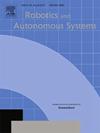虚拟现实下体触觉交互运动界面的设计与开发
IF 4.3
2区 计算机科学
Q1 AUTOMATION & CONTROL SYSTEMS
引用次数: 0
摘要
这项工作介绍了一个名为ForceBot的运动界面的设计、构建、控制和初步用户数据。它在虚拟现实(VR)中提供下半身触觉交互,使用户能够在虚拟现实中行走,同时与各种模拟地形进行交互。它利用两个平面龙门,给每只脚两个自由度和被动的脚跟提升运动。设计采用动作捕捉数据与动态仿真相结合进行人机工作空间和硬件选择。它的系统框架使用开源机器人软件,并与定制的电力传输系统配对,该系统提供具有1,000 Hz软实时计算率的EtherCAT通信。该系统具有导纳控制器来调节物理人机交互(pHRI),以及步行算法来生成步行运动和模拟虚拟地形。通过评估用户输入力和输出pHRI运动之间的关系的三个测量来探索系统的性能。总体而言,该平台提供了一种独特的方法,利用平面龙门架实现VR地形交互,具有广泛的工作空间,合理紧凑的占地面积和初步的用户数据。本文章由计算机程序翻译,如有差异,请以英文原文为准。
Design and development of a locomotion interface for virtual reality lower-body haptic interaction
This work presents the design, build, control, and preliminary user data of a locomotion interface called ForceBot. It delivers lower-body haptic interaction in virtual reality (VR), enabling users to walk in VR while interacting with various simulated terrains. It utilizes two planar gantries to give each foot two degrees of freedom and passive heel-lifting motion. The design used motion capture data with dynamic simulation for ergonomic human–robot workspace and hardware selection. Its system framework uses open-source robotic software and pairs with a custom-built power delivery system that offers EtherCAT communication with a 1,000 Hz soft real-time computation rate. This system features an admittance controller to regulate physical human–robot interaction (pHRI) alongside a walking algorithm to generate walking motion and simulate virtual terrains. The system’s performance is explored through three measurements that evaluate the relationship between user input force and output pHRI motion. Overall, this platform presents a unique approach by utilizing planar gantries to realize VR terrain interaction with an extensive workspace, reasonably compact footprint, and preliminary user data.
求助全文
通过发布文献求助,成功后即可免费获取论文全文。
去求助
来源期刊

Robotics and Autonomous Systems
工程技术-机器人学
CiteScore
9.00
自引率
7.00%
发文量
164
审稿时长
4.5 months
期刊介绍:
Robotics and Autonomous Systems will carry articles describing fundamental developments in the field of robotics, with special emphasis on autonomous systems. An important goal of this journal is to extend the state of the art in both symbolic and sensory based robot control and learning in the context of autonomous systems.
Robotics and Autonomous Systems will carry articles on the theoretical, computational and experimental aspects of autonomous systems, or modules of such systems.
 求助内容:
求助内容: 应助结果提醒方式:
应助结果提醒方式:


